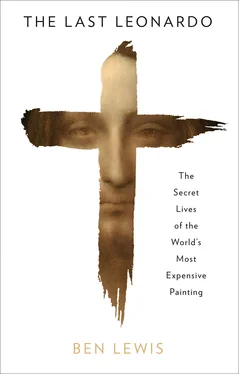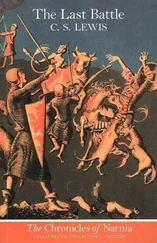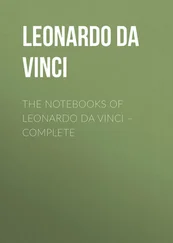While we see so many of the above Leonardesque attributes in the Salvator , other notable aspects of the painting are not very Leonardo . The composition, for one thing, is uniquely flat within the artist’s oeuvre. Christ has none of the movement and contrapposto we see in the figures in Leonardo’s other paintings, despite the fact that he had written ‘Always set your figures so that the side to which the head turns is not the side to which the breast faces.’ Rather than reinvent the composition of this traditional subject, Leonardo seems to have produced, for the first and only time in his life, a carbon copy of the static one that scores of other early Renaissance artists used. The typology of the Salvator Christ, with its long nose and sombre expression, is remote from the delicate, androgynous charm of the Christ he painted in The Last Supper and of a drawing of Christ he made around 1494. In fact, the facial features don’t resemble any of Leonardo’s drawings of other young men. The orb presents another problem. Its realism is undermined by the absence of any notable optical distortions in the drapery behind it, and of the reflections of the surroundings which would logically be visible in such a piece of crystal. Leonardo studied and wrote about optics at length in his notebooks; it is unlikely that he would paint such an object in such an unrealistic way.
After Martin Kemp accepted Robert Simon’s invitation to examine and research the Salvator Mundi , the Oxford art historian embarked on years of study of the painting in all its aspects, from its style to its iconography, and from its overall effect to its smallest details. The painting merits attribution to Leonardo, Kemp has elegantly written, because of
… the soft skin over the bony joints of the fingers of Christ’s right hand, implying but not describing anatomical structure; the illuminated tips of the fingers of his left hand, the glistening filaments of vortex hair, above all on the right as we look at the picture; the teasing ambiguity of his facial features, the gaze assertively direct but removed from explicitness; the intricately secure geometry of the angular interlace in the neckline and cross-bands of his costume; the gleaming crystal ellipse on the pendant plaque below his neckline; the fine rivulets of gathered cloth on his chest.5
The painting has, in short, ‘Leonardo’s magic’. Kemp finds great significance in the contrasting ways in which the face and hand were painted, the former softly, the latter crisply. Leonardo was the first artist to write about aerial perspective – the way colours and outlines fade the further away they are.‡ Kemp notes that the way the blessing hand comes forward in sharp focus towards the onlooker, while the face hovers in a mist of sfumato , is an application by the artist of his observations on the ‘perspective of disappearance’.
Kemp views the painting as Leonardo’s spiritual manifesto. The sign of this is the replacement of the conventional brass orb plus cross (the globus cruciger ), with a transparent globe. Through this adaptation Leonardo was representing the cosmology of the Graeco-Roman mathematician and astronomer Ptolemy, who believed that the earth was surrounded by a transparent ‘crystalline sphere of the heavens’, in which the stars were situated. ‘So what you’ve got in the Salvator Mundi is really a Saviour of the cosmos, and this is a very Leonardesque transformation,’ Kemp has said.6
In regard to some of the un-Leonardo-like aspects of the picture, Kemp has developed explanations. The flat composition can be understood as the influence of the Veil of Veronica, an image of Christ’s face, not dissimilar to the Turin Shroud, left when the eponymous saint wiped Jesus’s face with a piece of cloth. The subjects of the Salvator Mundi or Christ Pantocrator, which were very popular in Renaissance Europe, always showed Christ flat-on, looking straight towards the viewer. It was a serious subject, Christ as God, which demanded an austere and sombre treatment. If Leonardo’s painting had been made for a client, a conservative format might well have been insisted on. The explanation for the lack of optical distortions in the orb, Kemp suggests, is that Leonardo was making an artistic decision to break a rule in the interests of the overall impact of his painting. Distortions in the orb would be distracting. The artist was exercising the Renaissance virtue of decorum , or propriety.
But there are shortcomings in Kemp’s analysis. Regarding the significance of the orb, there is no evidence that Leonardo was a neo-Platonist, or even understood what the term meant. Certainly his paintings sometimes contain signs and symbols that refer to the name of the sitter or client, but suggestions that he referenced philosophical ideas as he did the names and coats of arms of his aristocratic patrons remain speculative. As for Leonardo’s depth of field, the alleged blurriness of Christ’s face is contradicted by the sharpness of the curls of his hair, which are in the same plane. One excerpt from Leonardo’s notebooks actually tells painters that if they are painting a figure in the distance, ‘do not single out some strands of hair, as the distance nullifies the shine of the hair’. It is a great mystery why a painting by an artist who studied optics, perspective and light with such intensity should contain two glaring optical inconsistencies. But that is not the greatest mystery of all.
For there is one feature of the Salvator Mundi about which neither Martin Kemp nor any other art historians have said anything at all. Perhaps they have dismissed it, or perhaps they haven’t noticed it. This feature is so individualistic that it can neither be associated with Leonardo’s painting nor disassociated from it; it belongs neither to the pictorial traditions of medieval Italy, nor to the symbology of early Christianity, nor to the classicising project of the Renaissance. The Salvator’s garments are of only one colour. In every other Italian Renaissance depiction of Christ he wears red and blue, almost always a red tunic and a blue robe. The Salvator wears only a blue garment, adorned with gold filigree embroidery. For the moment we have no explanation for this. Let us call it the blue clue.7
*Vasari explained why he thought Leonardo belonged to the third phase of the Renaissance: ‘In addition to the power and boldness of his drawing, not to mention the precision with which he copied the most minute details of nature exactly as they are, he displayed perfect rule, improved order, correct proportion, just design, and a most divine grace.’
†He probably saw rock crystal orbs of this transparency and size in Milan in the early sixteenth century. There is a large one in a museum in Dresden which was made in Milan in the 1570s, by which time Milan had become the centre of rock crystal carving in Italy – another reason to date the Salvator Mundi to Leonardo’s second Milanese period.
‡Leonardo wrote: ‘The nearest objects will be bounded by evident and sharp boundaries against the background, while those more distant will be highly finished but with more smoky boundaries, that is to say more blurred, or we may say less evident.’
CHAPTER 7
Vinci, Vincia, Vinsett
The word ‘provenance’, borrowed from French, describes a branch of art historical research the dictionary definition of which is ‘a record of ownership of a work of art or an antique, used as a guide to authenticity or quality’. It means the history of the collecting of a painting after it has been painted, as it passes from collection to collection. The study of provenance serves a practical economic purpose, since the value of a painting rises according to how important its previous owners were. Kings, queens and emperors are at the top of the scale, while middle-class factory managers are close to the bottom. The role of provenance in the economy of art was already recognised at the end of the seventeenth century. It attracted the curiosity of the Anglo-Dutch philosopher Bernard de Mandeville, who, referring to a series of Raphaels at an English royal palace, remarked:
Читать дальше












